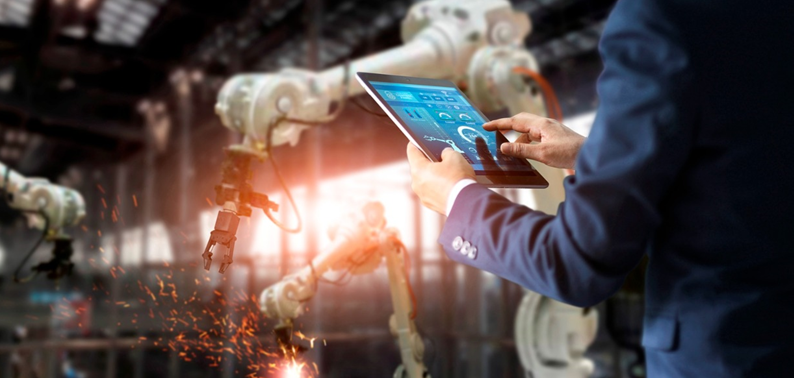Smart modelling-Simulation & Digital twins: the impact of simulation and replica in manufacturing
I4MS new technological application experiments are funded with the aim of encouraging the digitalization of European manufacturing SMEs, the current Phase 4 of the project will incorporate smart modelling, simulation, digital twins, laser-based additive, manufacturing, innovative, artificial intelligence, cognitive robotics and other autonomous systems focused on human-robot interaction.
I4MS through several open calls between 2020-2023. In this article, we will provide a brief description of one of the previously mentioned technology fields that will be key for the I4MS goals: smart modelling, simulation and digital twins.
Smart modelling and simulation help to take advantage of a predicted change
Simulations are key in order to define scenarios in the manufacturing sector, for example, to empirically predict the impact of a certain change (like the inclusion of a certain technology i.e. robots). Running a simulation would help to assess the impact of this change on the overall system. The use of simulation in manufacturing help:
1. evaluate the resources required
2. the overall performance
3. the management of operations
Under the category of modelling and simulation, we now have software that can model digitally designs of machines, equipment or systems, such as Computer-Aided Design (CAD) software, an essential tool of the industry that now can be enhanced with the application of Artificial Intelligence tools to give faster and more accurate results than before.

Digital Twins, a “living model that drives the business outcome”
Digital twins, on the other hand, refers to a digital replica of potential and actual physical assets (physical twin), processes, people, places, systems and devices that can be used for various purposes. The vice president, software research at the GE Global Research centre, Colin J. Parris, Ph.D. the functioning of digital twins:
Digital Twins are more complete systems that can simulate a whole factory floor with all its embedded systems.
The floor plan of the factory and its equipment which include sensors, mobile robots, forklifts and AGVs can be initially simulated and programmed by its digital twin saving resources and time, before applied to the real factory. All these technologies can be combined with extended use of High-Performance Computing (HPC). Get to know the OPIL project developed by the Logistics for Manufacturing SMEs. L4MS team (http://www.l4ms.eu/) is an acceleration programme, part of the I4MS greater project, with aim to help small and medium-sized manufacturing companies to adapt new technologies in factory logistics.

As the following paper3 presents, “virtual models can be used as a supplement to enrich the composition and functions of Cyber Physical Systems, so that Digital Twin technology can be considered a necessary foundation […] its combination would help manufacturers achieve more precise, better, and more efficient management”.
CloudiFacturing, an example of High-Performance Computing
Technologies like Digital Twins can be combined with extended use of High-Performance Computing (HPC) CloudiFacturing is also an acceleration programme, promoted under the I4MS umbrella of projects, which makes this connection.

The CloudiFacturig platform mission was to optimize production processes and producibility using Cloud/HPC-based modelling and simulation, leveraging online factory data and advanced analytics, thus contributing to the competitiveness and resource efficiency of manufacturing SMEs.
ENDEF, for example, was an Application Experiment derived from CloudiFacturing that optimized the lamination process in the manufacturing of hybrid solar panels. In this procedure, the adhesive between the photovoltaic module and the heat recovery unit is melted and cured through a thermal process in an oven, achieving the union of both components. The oven configuration (temperature ramp, air mass flow, and distribution) is critical to ensure proper thermal treatment of the adhesive along with the whole panel, to avoid hot spots or to reduce the energy consumption. The optimal configuration of the oven depends on external variables, such as the ambient temperature, the thermal properties of the adhesive and the geometry of the solar panel. Simulation of the lamination process: The aim is to minimize the energy consumption and power needed by the oven, as well as minimizing the time required per panel and the number of them with manufacturing defects.
ENDEF reduced the processing time by 20% and the energy consumption by 20% (short-term) and 30% (medium-term) of the lamination process as well as increase its production capacity. Adapting and porting a fluid flow and heat transfer simulation software package (based on Computational Fluid Dynamic techniques, CFD) to the Cloud to simulate and optimize the solar panels manufacturing, is what was tried to be achieved with this experiment. CloudiFacturing, an Innovation Action from I4MS Phase 3, empowered over 60 European organizations and supported 20 cross-national application experiments during the period 2018-2020.
Author: Mobile World Capital Barcelona



